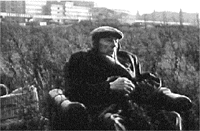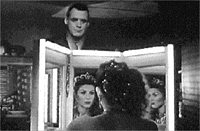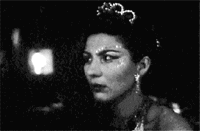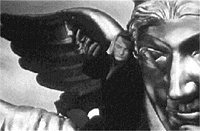|
The repetition of the words »Als das Kind Kind war« throughout the film, Wings of Desire is a sort of marker with many possible meanings. First, we have the poetic echoing of the word for Child (Kind) in the recurrent initiating sentence in the ongoing reflection on times past by different voices or voiceovers. The doubling puts emphasis on the »being«, the nature of childhood as existence, as opposed to non-existence or adulthood. It is as if the doubling sets up a space for reflection, a space almost as perceptible as when we ask from within the concept of spirit, using the German saying »wes Geistes Kind ist er?« (»What is his way of thinking like?/ What kind of a person is he?«). Childhood is, in other words, seen from within, but testified to by a voice from the outside. In poetry, we are used to listening to the spatial void between the word as readable text and its absent acoustic image. Here, we are presented with the voiceover (in French: voiceoff) figuring as an appendix to the written words on the screen. The time gap between then and now becomes more explicit in the absence of (the) person(s) speaking and/or writing. The paradoxical distance is produced by way of the proximity of sound and image - both presented as objects of language. Although we are looking at writing in its process of becoming, the meaning of this gesture is situated in the language as sense-words, as they bear witness to the past world of childhood. This composition can also be seen in the childhood section of Orson Welles´ Citizen Kane. The action (the flux of images) takes place, so to speak, from underneath the organisation of words. It is not a duality between body and language that is presented here in the opening sequence. As Gilles Deleuze teaches us: »the event subsists in language, but it happens in things«, [1] and sense is produced in between. Wenders makes us aware of this from the very beginning, and he makes sure that we do not forget it throughout the film. Secondly, the sentence »Als das Kind Kind war« presents the second »Kind« to us as if it were an adjective, marking an interim of becoming. The past of the verb is made actual in a virtual time-zone, filled with possible and never closed meanings. The poem activates itself as an event between sensation and thought - marking a ressource of possible meanings but also an awareness of »the unthought«, that marks us from the outside. The doubling implies with a Deleuzeian term a »crystalline split« - an active interim of child (as remembrance) and child (as virtual becoming). The words vibrate as if their virtual existence in remembrance could still be activated in a non-melancholic gesture. The doubling of »Kind« could of course be heard as an echo with modernistic pathos, where fullness (or excess) of meaning could only be articulated on the backdrop of loss and di-stance. But it is difficult not to hear it as the noemata of sense and sen-sation, presented as event in the poem itself. This intonation becomes more determinant throughout the film, when different continuations of the first sentence are added by the poet (Peter Handke). Those describe a (still reachable) world of sensations, awareness and direct interactions. It is as if the repetition of »Kind« in voice (and text) becomes a trope, a figure of speech, a rhetorical device to shatter conventional readings and ways of seeing thoughout the whole film. In this reading of »Kind«, it relates directly to the never-ending meaning of »angels«. The metaphysical aspect of angels is made physical by way of the child. And with Wenders as the director, it would not be an overstatement to argue that his aesthetic and political aim is a search for the potentiality of the moving image as happening or event. An aspiration on behalf of the spectator, who in principle is situated like an angel in front of the flux of images: unable to rearrange or change the course of events in filmic time. It is my belief that Wenders´ success with this movie is due to the direct discourse about what it means to make sense or to give sense. In this film, he relates to sense as something already established. Images and words could only be uttered on the basis of an already established sense, not as a metaphysic whole, free of the sensations of bodies, or as eternal or conventional truths, but as something that is part of bodies and texts as set from the outside. That is the function of the voiceover of the poet in Wings of Desire. It is situated, like angels, in the sky over the city of Berlin, not as a narrative device, a point of view of the discourse, but as »the outside«, that is the precondition for the production of sense. Sense as event, taking place in words and action as an effect of thoughts that could never be exhausted. Damiel, who forsakes the costume of angels and descends to this world of grief, pain, passion, blood and colours, expresses the intermediary field of sense as event, as he states: »Away with the world behind the world« or realises the meaning with the sayings: »Let´s plunge into time, into death!«, »We are not yet born, so let´s descend«, »To look at eye level rather than down from above«. The transmutation from angel to man is like the transmutation from thought to speech.
for the first time - and this is the effect of the film - man has to operate with his whole living person, yet forgoing its aura. For aura is tied to his presence; there can be no replica of it (op. cit. p. 223). The aura of the film actor vanishes, as Benjamin describes it, but the work of the camera lays down new laws regarding representation in altering the subject's relation to time and space: »With the close-up, space expands; with slow motion, movement is extended. The enlargement of a snapshot does not simply render more precise what in any case was visible, though unclear: it reveals entirely new structural formations of the subject« (p. 229-30). This complexity - the loss of aura, combined with the unforeseeable shocks of beauty and ugliness in modernity is maintained as the prevailing centre in his theoretical writings in the shadows of fascism. As Rainer Nägele states it, Benjamin abandons »representational models of mirror reflection (Widerspiegelung)« as well as »the dialectics of specular selfreflection« to create instead »a graphematic model of reflexive motility inscribing physiognomic traits«. [3] Sense, physicality, and the social and political body of the mass all take part in this description. It was not Benjamin's concern to alter the classical »philosophy of beauty« to »the modern beautiful« or to lament the loss of aura. He was, if anything, referring to »an earlier Kantian and preKantian notion of aesthetics as a theory of perception« (op.cit.). The experience of modernity in terms of sense-perception is often centred on visual perception in the texts mentioned. Samuel Weber suggests that the extensive use of words like »Bildlichkeit«, »Weltbild« or »Vorstellung« indicates a symptomatic description of modernity, where the world has become a picture - forever inscribed in representations where the place of the subject is fully depicted. But a different reading of the kinetic level of the moving picture as a recording or inscription, where elements are dislocated, cut, and then projected in many places at once inspires to new readings of technology and mass. The absentminded perception gives way to a study of sensations as a bodily and social experience. The moving image is, in this sense, presented as belonging to the level of allegorical pictures, the level of Proust´s involuntary memories, or the glance from a woman passing by in Baudelaire's poetry. The spell between appearance and disappearance must be fugitive in order to create sudden beauty or »mediauric« (Weber) effects:
auratic flashes and shadows that are not just produced and reproduced by the media but that are themselves the media, since they come to pass in places that are literally intermediary, in the interstices of a process of reproduction and of recording - Aufnahme - that is, above all, a mass movement of collection and dispersion, of banding together and disbanding. [4] It seems to me that Wim Wenders is indeed an heir to this kind of kinaesthetic philosophy or »Weltbilde«, that presents us with »Darstellungen« instead of reproductions of the same. Although the English title: Wings of Desire, has lost all reference to this auratic trace, this film is apparently showing us that the sky (of Berlin) also reaches to the ground. It can easily be seen as a kind of manifesto of Wenders' work, dedicated as it is to the story of Germany, the remembrance of material history inscribed in the ruins and places of the city, and in the bodies and thoughts of ordinary people. This perspective will dominate the following reading.
The portrait of the woman made visible succeeds. On a larger scale, the storyteller, Homer's, ambition to pile all the different voices together fails, as no one ever listens. The »immortal singer«, the »angel of poetry« is, in modern time, telling his story with a cracked voice »on the threshold of No Man's land« exactly as Benjamin states it:
the art of storytelling is coming to an end. Less and less fre-quently do we encounter people with the ability to tell a tale pro-per-ly. More and more often there is embarrassment all around when the wish to hear a story is expressed. It is as if something that see-med inalienable to us, the securest among our possessions, were taken from us: the ability to exchange experiences (Illuminations, p. 83).
Homer is presented to us as a stranger, an almost invisible old man (with strong similarities to the French philosopher Paul Riceur); only the angels notice him. He is related to death, and is, as such, in touch with the Muse as a link to the reminiscences of his personal story as well as to the remembrance of the story as an epic web. What makes Der Himmel über Berlin remarkable as a poetic manife-sto is that Wenders is actually using the figure of the storyteller as a germ to link images of today by way of allegorical correspondence. It is, in fact, striking that the revision of the film today, a decade after the fall of the Berlin wall, must deal with this in a sort of wondering: it is as if the film (produced in 1987) shows us (now) the obvious traces to follow (then). The figure of the storyteller, Homer, is (also) a crystalline image that presents to us an heir we should deal with. This heir has an invisible link to the recurrent invocation of the poetic voice on childhood, as well as the eternal remembrance of the angels. In that sense »Der Himmel« can be seen as the light from Eternity, the infinite space meeting with the inhabitants of Berlin, too vulnerable towards time. The picture, Angelus Novus, by Klee, interpreted by Benjamin as a figure, »the angel of history« and »progress« [5] can, by way of Wenders fallen angel, Damiel, now be read as an opening towards the time-image, where the movements and thoughts of human beings have no goal and no purpose and yet are more than just empty markers of time. Time is inscribed in us, not just as the physical death process, or from the viewpoint of eternity, but time as images, as events, that mark the past as virtuality. This is where hope is created: in the realm of time-images and stories with manifold endings, in the realm of events, where time, light and image have the same source, the »many diffuse occurrences« (op. cit., p. 97), that are the origin of epics. The epic tradition before the written story, the epos and the novel, concentrated on one story, »one hero, one odyssey, one battle« (op. cit., p. 97).
It turns in on itself; it is no longer a dependant, or something which is part of the visual image; it takes on a cinematographic autonomy and cinema becomes truly audiovisual. […] Thus it is no longer a question of action/reaction, nor of interaction, nor even of reflection. The speech act has changed its status. If we go to 'direct' cinema, we fully discover this new status which gives speech the value of a free indirect one: this is storytelling. [6] Deleuze is exploring the storytelling voice with reference to Perrault, Rouch, Rohmer and Bresson, but it is hard not to include Wenders, as he continues:
The break in the sensory-motor link does not only affect the speech act turning in on itself and hollowing itself out, and in which the voice now refers only to itself and to no other voices. It also affects the visual image, which now reveals the any-space-whatevers, empty or disconnected spaces characteristic of modern cinema. It is as if, speech having withdrawn from the image to become founding act, the image, for its part, raised the foundations of space, the 'strata', those silent powers of before or after speech, before or after man. The visual image becomes archaeological, stratigraphic, tectonic. Not that we are taken back to prehistory (there is an archaeology of the present), but to the deserted layers of our time which bury our own phantoms; to the lacunary layers which we juxtaposed according to variable orientations and connections. These are the deserts in German cities (op.cit., pp. 243-44, Deleuze's emphasis). This striking characterisation of Der Himmel über Berlin, two years before its release, is very complementary to Benjamin's way of thinking. Perception becomes the centre of seeing an image. We read images today as witnesses to our own perception. We see and hear with analytical eyes and ears because we no longer can relate to the explicatory force of relating images or sounds. The distancing gap makes it possible. »The empty and disconnected spaces«, already visible in Ozu's films, function as a »division of labour between presentational image and representational voice" (op.cit., p. 246-47). It is the separation of the two aspects of perception, seeing and hearing, that is used as a technique to recall the auratic figure of Benjamin. The space that separates us from auratic art is virtually present as a germ of remembrance in this non-correspondence of voice and image. This is where we meet the wondering Marion, most strikingly portrayed in front of her mirror-triptycon, where she watches herself think. As the internal voiceover speaks: »So what do you think?«, the camera moves to the back of the mirror. We see the face of Marion in a dark reflection, a shadow on an opaque background. She is presented to us as if in a crystal-image - but this image has the power to transform meaning. She is not portrayed like the old woman (sketched by Peter Falk) in relation to her (and our) past. Marion is portrayed in relation to her virtual future, trying to confront her thoughts with the un-thought. The voiceover is answering her questions so to speak from the backside of the mirror like an automat from the outside. Marion listens to the death inside life, the dread of anxiety, and she becomes alive as the thought from the outside marks her body - as life within death. It is thought, that breaks the spell of the crystall as frozen. The crystal image is broken or unfolded and makes way for a time-image.
Her metaphysical fear of death is transformed to a physical reassurance of her body: »You´re not blind yet. Your heart is still beating. And now you´re crying«. This time-image transforms an angst for nothingness to a fear of the inscriptions of time in the body. The physical death process is not frightening to Marion as long as it is concrete. On this background, she can return to her spatially disconnected stasis. But she is without fear, and can describe the trapezian figure one last time as an upheaval of gravitation. The angel, Damiel, makes the opposite movement: from the outside to the inside, from sky to earth, from the world of metaphysical truths to the world of presentations. He descends. That´s why there is humour linked to his person. He wants to taste life, to reunite the disconneted spaces. He wants to undo the absence of aura, to become like a child, to undo the passive figure of Angelus Novus. To break open the concept of progress. And he succeeds. Wenders describes a possible flight into virtual images of the past, re-figured in actual images (the old woman). A flight of thought-creation, that submits to the conditions of time: the present as forever splitting up into past-present and future-present (Marion). A flight of pure events and qualities of sense, sound, image (Damiel). Those images might open our minds to a new cinema, where stories could be told without the boundaries of old manners of re-pre-sentation - and in fact they did!. As a concluding remark, I would like you to look again at the isolated figure of Cassiel, as he, at the end of the film (sitting on the angel-sculpture), suddenly stops his ears and the sound disappears. It is as if the noisy space were more than spatial. Time expands in this momentary silence, and time-space occurs in an almost sensual touch that makes sense. We are suddenly able to hear the passage between sound and its disapperence. The pause is given meaning as an intermediary between camera-noise and thought, between sensation and knowledge - a pure sound-image.
[1] Gilles Deleuze, The Logic of Sense (London: Athlone Press, 1990), p. 24. [2] The mentioned essays are collected in Illuminations 1955, paperback edition (London: Fontana Press, 1992). [3] Rainer Nägele: »Poetic Ground Laid Bare«; Walter Benjamin: Theoretical Questions, ed. by David S. Ferris (Stanford University Press, 1996), p. 136. [4] Samuel Weber: »Mass Mediauras«; Walter Benjamin: Theoretical Questions, op. cit., p. 48. [5] Illuminations, op. cit., p. 249.
[6] Gilles Deleuze, Cinema 2: The time-image (Minneapolis: The Athlone Press, 1989).
|



